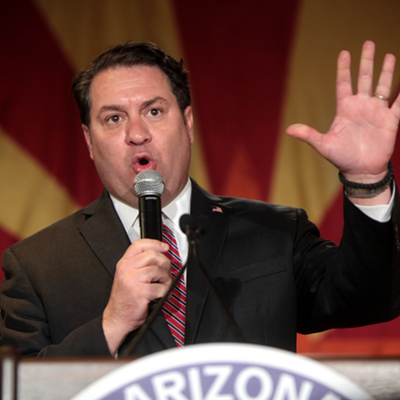• What was the big takeaway in the legislative races? Conservatives ruled. In almost every local race in GOP districts, the most conservative candidates carried the day.
In the GOP primary for the Legislative District 26 Senate seat, Republican Al Melvin beat state Rep. Pete Hershberger by exposing his liberal leanings, just as Melvin beat incumbent Toni Hellon two years ago. Melvin captured 10,131 votes compared to Hershberger's 8,857 in the district which runs from SaddleBrooke down through Oro Valley and across the Catalina Foothills.
Now comes the big test for Melvin: Can he win a general election? Melvin has sanded down many of his rough edges, but he's facing a savvy Democrat in Cheryl Cage, who managed a Democratic campaign that was able to overcome the GOP voter advantage in the 2006 District 26 House race. On top of that, the political mood still doesn't favor Republicans, although having the McCain/Palin team at the top of the ticket may help energize the GOP here in Arizona.
In the GOP race in the District 26 House race, Marilyn Zerull managed to eke out a 50-vote victory over Trent Humphries for the second-place slot. Humphries, who got 9,355 votes compared to Zerull's 9,405, was undoubtedly the stronger general-election candidate, but the GOP voters went with Zerull, perhaps because she quietly allied herself with Melvin. (Or it could have been the Tucson Weekly's endorsement of Humphries that did him in. Sorry 'bout that, Trent!)
The one guy who beat the conservative streak in the LD26 Republican primary was Vic Williams, who was more moderate than both Zerull and Humphries. He came in first with 10,737 votes. We're not sure how he managed to prevail while moderates were falling all around him, although we suspect it has to do with the odd dynamics of having three people in a race in which every voter has two choices.
Williams and Zerull will now have to face Democrats Nancy Young Wright and Don Jorgensen, who will be fighting to at least hang on to the House seat the Democrats now hold. Both Democrats are loaded with Clean Elections funds, as is Zerull.
The Democrats may also have a shot in Legislative District 30, which includes eastern Tucson, Green Valley and Sierra Vista.
Rep. Jonathan Paton, who faces 83-year-old Democrat Georgette Valle in the Senate race, probably doesn't have too much to worry about; Paton captured 18,783 votes in his unopposed primary, more votes than any other legislative candidate in the state.
But the two most conservative candidates won the Republican House nominations in the GOP-leaning district. After losing in 2004 and 2006, David Gowan finally won a GOP primary with 10,981 votes. Coming in second was Frank Antenori, with 8,370 votes. Doug Sposito grabbed third place with 7,858 votes, and Sharon Collins trailed with 7,616.
Gowan and Antenori will now face Democrat Andrea Dalessandro, who will have close to $20,000 in Clean Elections dollars and support from the Arizona Democratic Party, which has hundreds of thousands of dollars for get-out-the-vote efforts and the occasional hit piece.
• How did the conservatives do elsewhere in the state?
They kicked ass. We don't have space to go into all of the details, but with few exceptions, a crew of moderate Republicans lost to their more conservative opponents.
• Why'd the conservatives do so well?
You can give a lot of credit to the Clean Elections program, which powered many of the conservatives, including Melvin, Gowan and Zerull down here. This is the third wave; in 2004 and 2006, the moderates started getting killed off in primaries.
The big question: Do the conservatives lean so far right that Democrats can beat them in districts where the GOP has the registration edge? If it's ever likely to happen, it'll be this year, when the Democrats have plenty of money and the political zeitgeist in their favor.
• Speaking of Democrats: Why did incumbent Rep. Tom Prezelski lose in Legislative District 29?
Prezelski found himself in an extremely competitive seven-way race, and he wound up losing to the hyper-organized Matt Heinz, who got 3,771 votes, and the hyperactive Daniel Patterson, who got 2,572 votes. Prezelski, who didn't get his Clean Elections funding until two weeks after early ballots went out, came in third with 2,348 votes.
• Democrat John Kromko wasn't able to knock out either incumbent in Legislative District 27. Is he done for good?
Oh, we think we'll always have Kromko to kick around, although his win-loss record looks worse every time he gets near a ballot box. Since he left the Legislature in the early '90s, Kromko has lost one campaign for the county Board of Supervisors, two campaigns for the Legislature and two campaigns for justice of the peace.
• What did we learn about the Pima County Board of Supervisors?
The issue of election integrity may galvanize a vocal group of activists, but it has yet to resonate with most Democrats. Despite pounding that issue, Donna Branch-Gilby could only muster about 40 percent of the vote against District 3 Supervisor Sharon Bronson. The incumbent's strong showing makes her the comfortable favorite against Republican Barney Brenner in November.
We thought the District 3 race would be close, but it was actually Republican Joe Higgins who came the closest to pulling off an upset, against District 1 Supervisor Ann Day. Higgins came within 6 percentage points, losing by roughly 1,000 votes.
Democrat Ramón Valadez captured 70 percent of the vote while dispatching Robert Robuck.
• Why did it take so long to count the ballots?
A lot of the blame has been laid on the county's new security procedures, which prevent the transmission of results over phone lines from each precinct, because the election-integrity crew is scared that a sophisticated hacker could intercept and/or alter results.
That means the electronic scanners have to be carted down to Election Central before the vote counts can be uploaded into the central tabulator. Some of those ballot boxes are coming from rural spots such as Ajo.
The bulk of the uploading was resolved by Wednesday, but many of us in the media elite are complaining that we want the data faster so we can get our stories done without having to stay up all night.
Even if they do work something out on that front before Nov. 4, they've still got to worry about early ballots getting dropped off on Election Day, which held up the final tally in a few close races.
Thanks to a new permanent early-voter list, a record two-thirds of the voters--more than 76,000 of the 114,500 or so who voted--cast early ballots.
But somewhere around 11,000 of those early ballots didn't get back to the county until Election Day, arriving by mail or getting dropped off at polling places.
That meant all the signatures on those ballots had to be checked by Pima County Recorder F. Ann Rodriguez's staff before they could be counted.
To Rodriguez's credit, she had all those early ballots checked by end of the day Wednesday, but then she had to roll through about 3,000 provisional ballots, which require a closer look. She delivered the last batch of those to the Elections Division on Friday, Sept. 5.
Pima County elections chief Brad Nelson says he was able to wrap the final count by Sunday, although he was still tabulating some meaningless write-in ballots on Monday.
• What does that mean for the Nov. 4 general election?
In 2006, the Recorder's Office had to process 18,000 early ballots that were dumped on them on Election Day. What do you bet we break a new record this year?












